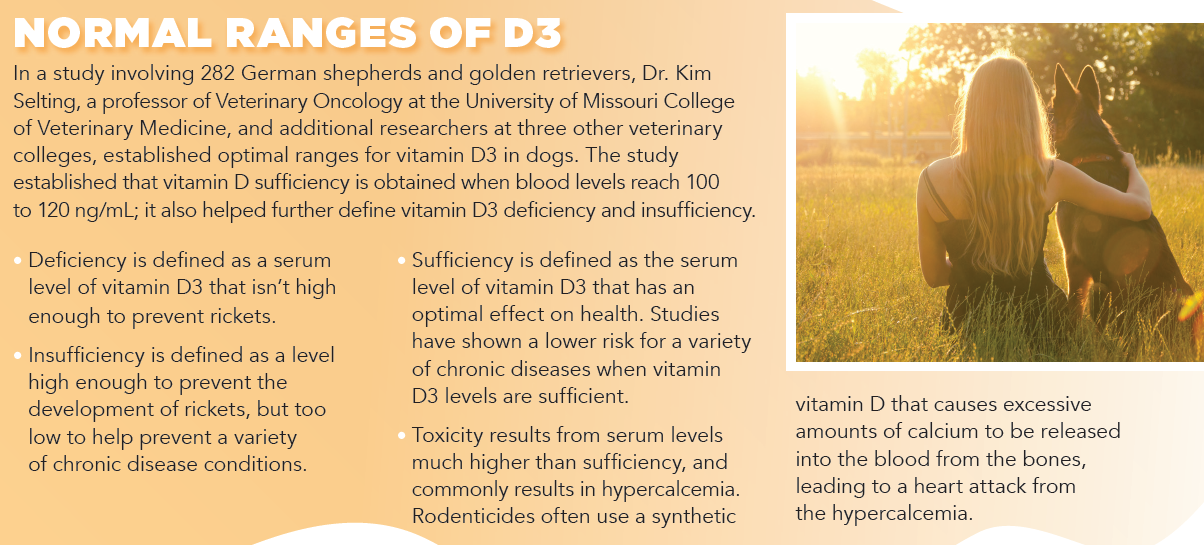Vitamin D – is your dog or cat getting enough?

Unlike us, dogs and cats can’t get their vitamin D from spending time in the sunshine. So it’s a good idea to have your furry friend tested to see whether or not he needs a supplement.
Many people take vitamin D supplements, and for good reason. low levels of this vitamin are associated with a variety of serious health issues, including cardiovascular disease and hypertension, cancer, diabetes, multiple sclerosis, asthma, infectious diseases, rickets and more. Researchers have uncovered similar findings in dogs and cats. Congestive heart failure, neoplasia, renal and infectious diseases, IBD, feline oral resorptive lesions (FORL), and other conditions are all connected to a deficiency of vitamin D in these animals.
D in detail
Vitamin D is made up of a group of steroid-like molecules. It’s similar in structure to other steroid hormones like testosterone, aldosterone, estradiol, progesterone and cortisone.
In order for vitamin D to be effective, it needs to bind to a receptor. The vitamin is like a key that fits perfectly into a lock – the membrane receptor. Once the two are “mated”, the vitamin can have a positive effect on the body. In humans, vitamin D receptors have been found in a wide variety of tissues. The vitamin is also believed to regulate over 2,000 genes.
Once ingested orally, vitamin D undergoes chemical changes in the liver and tissues that convert it to an “activated” form. It has an anti-inflammatory effect in tissues where it is active. Chronic inflammation underlies many conditions, including neoplasia and immune-mediated disease. However, studies have shown that serum levels of vitamin D high enough to prevent rickets are still insufficient for maintaining cellular health and dampening inflammatory processes. As a result, many professionals in the medical community suggest that people and animals be supplemented with an oral dose of this vitamin.
 Vitamin D regulates the absorption of calcium and phosphorus from the bowel, and is involved with calcium mobilization from bone. When derived from animal sources, it is termed cholecalciferol and converts to vitamin D3. Ergocalciferol is the plant-sourced form, and converts to vitamin D2. Most species are able to utilize both forms, although in cats, cholecalciferol (D3) maintains vitamin D status with greater efficiency than ergocalciferol (D2). Vitamin D2 does not prevent or reverse rickets, as compared to vitamin D3.
Vitamin D regulates the absorption of calcium and phosphorus from the bowel, and is involved with calcium mobilization from bone. When derived from animal sources, it is termed cholecalciferol and converts to vitamin D3. Ergocalciferol is the plant-sourced form, and converts to vitamin D2. Most species are able to utilize both forms, although in cats, cholecalciferol (D3) maintains vitamin D status with greater efficiency than ergocalciferol (D2). Vitamin D2 does not prevent or reverse rickets, as compared to vitamin D3.
- Dogs and cats, unlike humans and most other species, are unable to naturally convert very much vitamin D in their skin when exposed to ultraviolet light. Pro-vitamin D3 (7-dehydrocholesterol) in the skin of dogs and cats has a much lower concentration than that found in the skin of species that can convert 7-dehydrocholesterol to cholecalciferol. For this reason, dogs and cats differ from people and other animals in that they derive all this vitamin from food, and none from sunlight.
The cancer connection
Several studies measured the relationship between serum vitamin D concentrations and the incidence of certain types of cancer. Oral supplementation with this vitamin that’s sufficient to create healthy serum levels may be a credible strategy in the prevention of some cancers.
- One interesting finding from Dr. Selting’s study (see sidebar) is that neutered male dogs have, on average, lower serum vitamin D concentrations. Neutered male dogs also have an increased prevalence of cancer, as well as knee injuries. Given the relationship between this vitamin and bone development, there may be a link between insufficient levels of the vitamin and cruciate ligament disease.
- Dr. Selting’s study also measured serum concentrations of vitamin D in 62 dogs presenting with blood in their abdominal cavities as a result of various cancers such as hemangiosarcoma and splenic malignancies, and compared them to 282 dogs without cancer. Lower levels of vitamin D were found to be associated with a higher risk of cancers of the spleen.
- A separate 2011 study found that 33 Labrador retrievers with cutaneous mast cell tumors had significantly lower serum concentrations of vitamin D3 than 54 unaffected controls. It is unknown if supplementing with vitamin D3 could prevent mast cell tumors or improve treatment outcomes, but studies evaluating that possibility are underway.
- In yet another study, vitamin D levels in dogs with cancer were found to be significantly lower than those in dogs without the disease. The cancer types looked at by the study included:
- Carcinoma
- Histiocytic sarcoma
- Hemangiosarcoma
- Lymphoma
- Sarcoma
This evidence strongly supports the value of having your dog or cat’s vitamin levels measured, and of providing him with a supplement of vitamin D3 if his levels are insufficient. Start by taking him to the veterinarian for an initial blood sample to measure his baseline vitamin D levels. Based on these test results, it can then be supplemented orally for one to two months. At this point, his serum levels of the vitamin should be re-tested, and annual tests done thereafter to ensure they remain at sufficiently healthy levels (100 to 120 ng/ml).
Though it’s known as the “sunshine vitamin”, it’s important to remember that your dog or cat can’t get vitamin D from spending time outdoors. Given its many health benefits, it’s more than worth your while to get to know this nutrient better, have your companion’s levels checked on a regular basis, and consider supplementation.



